

Ballade sur les routes de l'Egypte / Le blog de Meretseger (début page 40) L'espoir en l'immortalité dans l'Egypte ancienne des origines au Moyen Empire. La_magie. The concepts of Akh , Ba and Ka. ANCIENT EGYPT : The Discourse of a Man with his Ba. Introduction This famous work is preserved in a single manuscript from the XIIth Dynasty.
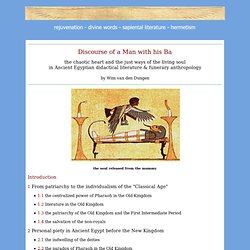
In 1843, the egyptologist Lepsius puchased this nameless hieratic papyrus and brought it to Berlin were it became "Berlin Papyrus 3024". In 1859, he published the text without translation. The first transcription & translation was by Adolf Erman in 1896, under the title : Das Gespräch eines Lebensmüden mit seiner Seele. The Egyptian text can also (partly) be found in Sethe's Aegyptische Lesestücke (1928). Faulkner published his translation as : "The Man who was tired of Life" (in JEA, n°42, 1956, pp.21 - 40). According to Assmann in his Maat (1999), this highly remarkable work belongs to what he calls "discourses on Maat" or "sapiental literature", consisting of teachings & complaints. ANCIENT EGYPT / Studies in Ancient Egyptian Religion & Philosophy. ANCIENT EGYPT : The Eyes. With the mythological symbol of the Eye, we touch upon what has been called "the key to the religion" (Clark, 1959, p.227).

It is also the most complicated of Egyptian symbols. The two Eyes (one in the primeval waters and one in the ideal society) was the most common & popular symbol in Egyptian thought. But even before the Dynastic Period, both in Asia and Europe, an eye or eyes represented a Neolithic fertility goddess. The general word for "eye" in Egyptian is "irt" (pronounced "eeret"), a feminine noun. La conception du cœur dans l’Égypte ancienne. The Ancient Egyptian Concept of the Soul. By Caroline Seawright To the Ancient Egyptians, their soul, their being, were made up of many different parts.
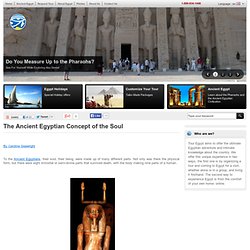
Not only was there the physical form, but there were eight immortal or semi-divine parts that survived death, with the body making nine parts of a human. The precise meaning of ka, ba, ach (akh), `shm (sekhem), and so on is no longer clear to us. Well-meaning scholars try again and again and again to force the Egyptian idea of the soul into our traditional categories without enabling us to understand even a little of it any better -- J. Les 9 CONSTITUANTS de l'ÊTRE / site "Immortelle Égypte" Un peu de mythologie » L'Égypte pharaonique : Rites et croyances D'après Le Livre des Morts, avec l'aide du docteur Michèle Broze L'ancien Égyptien accorde à la vie dans l'au-delà plus d'importance qu'à l'existence terrestre.
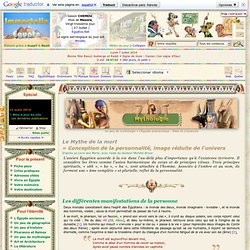
Il considère les êtres comme l'union harmonieuse du corps et de principes vitaux. Les composants de l'être Humain en Egypte antique. Salle des deux Maat, la Djadjat Comprendre la religion égyptienne, c'est appréhender ce que fût dans l'esprit des anciens, la place de l’homme dans la cosmogonie, que dis-je, les cosmogonies, de l’Égypte ancienne.
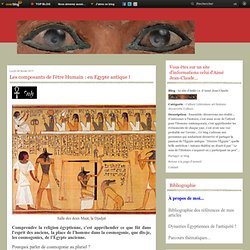
Pourquoi parler de cosmogonie au pluriel ? Plusieurs millénaires de longévité peuvent engendrer plusieurs courants ... Ainsi, peut-on citer : Symboles Egypte Ancienne. Parts of the Soul. Maat. The earliest surviving records indicating Maat is the norm for nature and society, in this world and the next, were recorded during the Old Kingdom, the earliest substantial surviving examples being found in the Pyramid Texts of Unas (ca. 2375 BCE and 2345 BCE).[2] Later, as a goddess in other traditions of the Egyptian pantheon, where most goddesses were paired with a male aspect, her masculine counterpart was Thoth and their attributes are the same.
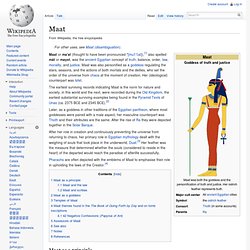
After the rise of Ra they were depicted together in the Solar Barque. After her role in creation and continuously preventing the universe from returning to chaos, her primary role in Egyptian mythology dealt with the weighing of souls that took place in the underworld, Duat.[3] Her feather was the measure that determined whether the souls (considered to reside in the heart) of the departed would reach the paradise of afterlife successfully. Maat as a principle[edit] La symbolique hiéroglyphique : "KA" Aujourd'hui, la vision que nous portons sur le monde se nourrit de la promesse d'un Futur où l'homme serait enfin affranchi des poids du temps et de l'espace.
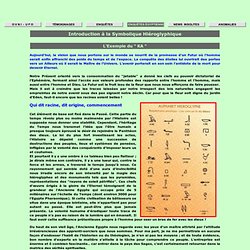
La conquête des étoiles lui ouvrirait des portes vers un Ailleurs où il serait le Maître de l'Univers. Papyrus of Ani: The Egyptian Book of the Dead. Ancient Egyptian Gods. Pharaohs also practiced this god’s concept of order during their reign.
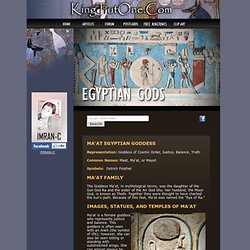
Pharaohs were expected to practice Ma’at, which meant it was their job to keep their nation in a state of order. This meant building temples, making offerings to the gods, keeping enemies at bay, and making honest decisions. Anything else was considered chaos and disorder. The people of Egypt believed that through Ma’at, the pharaoh kept Egypt stable and orderly. To some pharaohs, Ma’at was so intertwined into their kingdoms that some pharaohs changed their staffs’ names to accommodate this god. Ma’at’s Concept of Justice and Truth Ma’at is also known as the goddess of justice and truth. When a person died, their heart was weighed against the goddess’ feather on a huge scale. Maat Goddess of Truth and Justice ~ Ancient Egypt Facts. Maat ; Maât ; deesse Egypte. Le concept de la Maât regroupe plusieurs aspects totalement indissociables dans l'imaginaire égyptien.
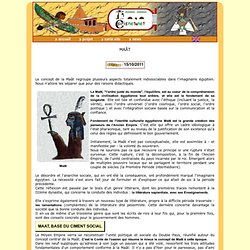
Nous n'allons les séparer que pour des raisons didactiques. La dualité égyptienne / site "Immortelle Égypte" Un peu d'histoire » L'Égypte pharaonique : Pharaons et Reines Plan de l'article La dualité : clef essentielle du système de pensée égyptien ¤ Tout est binaire » Sema-Taouy ou le pouvoir de Maât ¤ La dualité et l'union en images Nom féminin.

Caractère de ce qui est double en soi ; coexistence de deux éléments différents. - Dualité de l'homme. Maat, fondement de la pensée égyptienne. La symbolique des couleurs en Egypte ancienne. Les graphies du mot « couleur » en Egypte ancienne Comme souvent dans l’écriture hiéroglyphique, plusieurs graphies du même mot existent : iwn est la graphie principale, elle signifie à la fois « couleur » et « nature » (à noter que la graphie est composée des hiéroglyphes « roseau », « cheveu » et d’une ondulation rapide, celle du pinceau ?)
, ou irtyw signifie à la fois « couleur » en nom et « bleu » en adjectif. La signification des couleurs pour les anciens Egyptiens. Dans l'Egypte ancienne "Parmi tous les systèmes d'écriture au monde, l'écriture hiéroglyphique est unique grâce à la possibilité supplémentaire qu'elle offre de différencier les signes par les couleurs. Egyptian Colors. Maat (Egyptian Goddess) Maat. In Egyptian mythology, Maat is the goddess of order, the world's balance, equity, peace, truth and justice. It is the antithesis of Isfet (the god of chaos, injustice, social disorder). Maat is an entity symbolizing the universal standard: a balance established by the Creator, which allows Justice to act according to the law, truth, honesty and trust. Unlike most Egyptian gods which were depicted with animal features, Maat is always anthropomorphic, and like most abstract concepts is personified as a woman, usually sitting on her heels, or standing.
Maat is usually depicted as dressed in the long tight-fitting dress of the goddesses and as wearing the jewelry of the gods. Maat is the first divine dimension: she is the mother of Ra but she is also the daughter and wife of Ra and the mystical sister of the Pharaoh. Thus, Maat is fundamentally linked to the Pharaonic institution: the first duty of the pharaoh is to enforce the law of Maat throughout Egypt. Ancient Egyptian concept of the soul. Ib (heart)[edit] To ancient Egyptians, the heart was the seat of emotion, thought, will and intention. This is evidenced by the many expressions in the Egyptian language which incorporate the word ib, Awt-ib: happiness (literally, wideness of heart), Xak-ib: estranged (literally, truncated of heart).
This word was transcribed by Wallis Budge as Ab. Le concept de Maât / site "Immortelle Égypte" Un peu d'histoire » L'Égypte pharaonique : Pharaons et Reines La pensée philosophique des anciens Égyptiens était étroitement liée à leurs croyances religieuses. La société égyptienne était basée sur le concept de Maât qui signifie équilibre et ordre. Pour les anciens Égyptiens, la conduite idéale était à la fois pratique et religieuse. Recherche Wikipedia pour « pensée égyptienne » Concepts metaphysiques. Les Egyptiens pensaient que tout individu se composait de sept éléments: le corps, le nom, l’ombre le cœur, l’akh, le ba et le ka; certains de ces termes sont malaisés à appréhender car ces notions n'existent pas dans notre concept corps, âme et esprit.
Les termes de Akh, Ba et Ka désignent les composantes de la partie spirituelle des hommes Ba représenté sous la forme d'un oiseau Tombe N° 359 à Deir El Medina. B_Menu_La_notion_de_Maat-2006.pdf. L'anticipation dans la pensée de l'Egypte antique / Claude Traunecker. La Pensée Egyptienne. Pensée egyptienne antique.